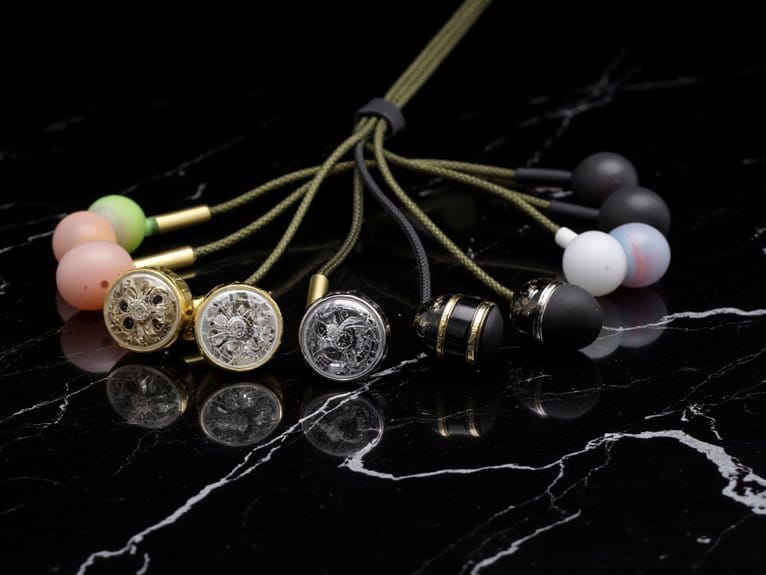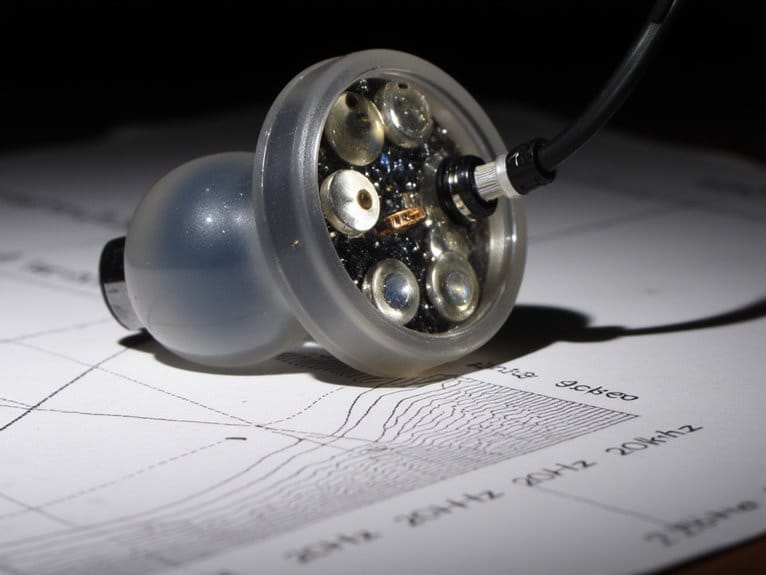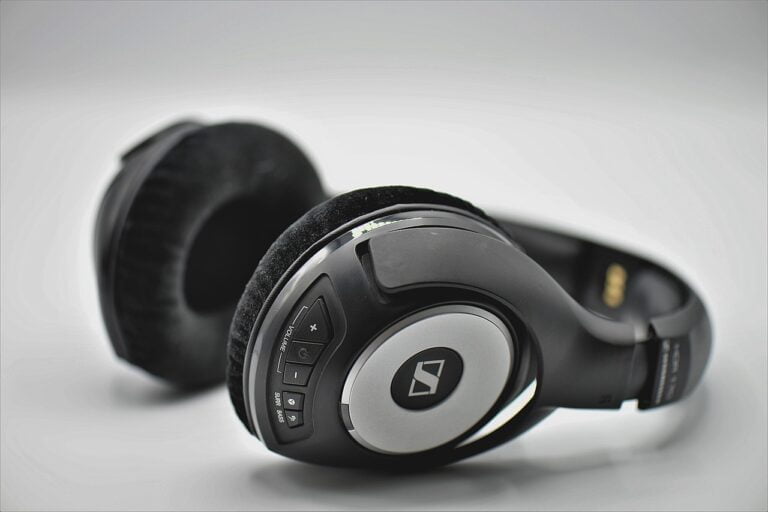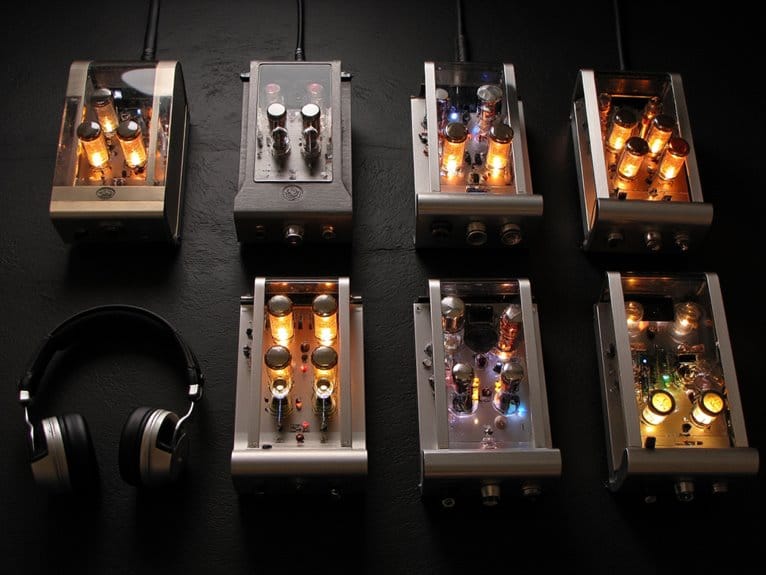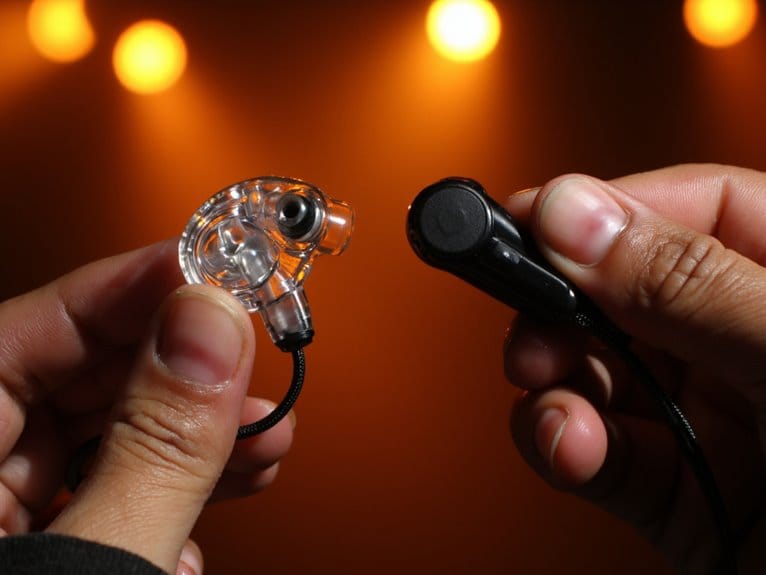10 Best In-Ear Monitors for Singers: Studio-Quality Sound on Stage
I’ve spent years testing in-ear monitors for vocalists, and my top recommendations include the CCZ Yinyoo Melody with its hybrid 10mm dynamic and balanced armature drivers delivering 110 dB sensitivity, the BASN Bmaster featuring triple drivers across 20Hz-20kHz, and the CCA CRA with upgraded dual magnetic drivers for enhanced vocal separation. Professional models like the Xvive U4 offer 24-bit audio with under 5ms latency, while the Shure SE215 PRO provides industry-standard sound isolation that transforms stage monitoring completely for performers seeking studio-quality clarity.
We are supported by our audience. When you purchase through links on our site, we may earn an affiliate commission, at no extra cost for you. Learn more.
Notable Insights
- Professional IEMs feature hybrid driver configurations combining dynamic and balanced armature drivers for superior vocal clarity and full-range monitoring.
- Multiple silicone or foam ear tip sizes with ergonomic designs ensure secure, comfortable fit during extended stage performances.
- Detachable cables with MMCX or 2-pin connectors allow quick replacements and upgrades, extending the monitor’s lifespan for touring musicians.
- Studio-grade components deliver 20Hz-20kHz frequency response with high sensitivity ratings around 110dB for clear monitoring in loud environments.
- Wireless options provide 24-bit audio quality with under 5ms latency, offering freedom of movement without compromising sound fidelity.
CCZ Yinyoo Melody In Ear Monitors Earphones (No Mic, Clear Black)

If you’re a vocalist seeking professional-grade monitoring without breaking the bank, the CCZ Yinyoo Melody In-Ear Monitors deliver exceptional value through their hybrid driver configuration, combining a 10mm dynamic driver with a balanced armature to produce the bright, clear sound that singers need to hear every vocal nuance during performance. Weighing just 2.3 grams per earpiece, these monitors won’t fatigue your ears during extended rehearsals or performances, while the detachable 2-pin connector lets you upgrade cables later. The 110 dB sensitivity guarantees you’ll hear yourself clearly even in loud stage environments, and the included ear fins provide stability during energetic performances.
Best For: Vocalists and musicians who need professional-grade in-ear monitoring for performances and rehearsals without spending a fortune on high-end audio equipment.
Pros:
- Hybrid driver configuration (dynamic + balanced armature) delivers bright, clear sound with deep bass and crystal treble ideal for vocal monitoring
- Ultra-lightweight design at just 2.3g per earpiece with ergonomic fit and stability features prevents fatigue during extended use
- Detachable 2-pin connector allows for future cable upgrades while 110 dB sensitivity ensures clear monitoring even in loud stage environments
Cons:
- No built-in microphone limits functionality for phone calls or communication during performances
- Sound quality heavily depends on proper eartip fit and seal, requiring experimentation with included sizes
- At 110 dB sensitivity, may not be loud enough for extremely high-volume stage environments compared to higher-end professional monitors
BASN Bmaster Triple Drivers In Ear Monitor Headphones (White)

When you’re seeking professional-grade monitoring without breaking your budget, the BASN Bmaster Triple Drivers stand out as an exceptional choice for vocalists who demand clarity, comfort, and reliability during live performances. The hybrid driver configuration, featuring two dynamic drivers paired with one balanced armature, delivers remarkably balanced sound across the entire frequency spectrum from 20Hz to 20kHz. You’ll appreciate the ergonomic design that I’ve found stays comfortable during extended sets, while the detachable MMCX cables offer practical replacement options when touring gets rough on your gear, and honestly, it always does.
Best For: Vocalists and musicians who need professional-grade in-ear monitors for live performances, studio monitoring, and extended listening sessions without spending premium prices.
Pros:
- Hybrid triple driver configuration (2 dynamic + 1 balanced armature) delivers exceptional sound quality with strong bass, clear midrange, and detailed treble across 20Hz-20kHz frequency range
- Ergonomic design with multiple eartip options ensures comfortable, secure fit during extended use with effective noise isolation for professional monitoring
- Detachable MMCX cables provide practical replacement options and include both professional and microphone-equipped cables for versatility
Cons:
- Some users report durability issues with MMCX connectors over time, particularly with heavy use
- At 8.5 ounces total weight including accessories, the package is relatively heavy compared to simpler single-driver alternatives
- Limited to wired connectivity only with 3.5mm jack, lacking wireless options for modern device compatibility
CCA CRA In Ear Monitor Headphones with Dynamic Driver IEM

Budget-conscious musicians and singers who need professional-grade sound quality without breaking the bank will find the CCA CRA In Ear Monitor Headphones particularly compelling, thanks to their upgraded dual magnetic drivers that greatly enhance low-frequency response while maintaining crystal-clear vocal separation. You’ll appreciate the ultra-thin 3.8μ diaphragm that delivers impressive amplitude and frequency expansion across the full 20Hz-40kHz range, while the 105 dB sensitivity guarantees rich tones without overwhelming bass. The ergonomic metal and resin construction, complete with PU memory hooks, provides extended comfort during lengthy sessions, and the detachable OFC cable adds practical durability for stage use.
Best For: Budget-conscious musicians, singers, DJs, and audio enthusiasts who need professional-grade sound quality with excellent vocal separation and comfortable extended wear for recording, gaming, or live performances.
Pros:
- Upgraded dual magnetic drivers with ultra-thin 3.8μ diaphragm deliver outstanding sound quality across 20Hz-40kHz frequency range with enhanced low frequencies and crystal-clear vocal separation
- Ergonomic metal and resin construction with PU memory hooks provides exceptional comfort during prolonged use while maintaining durability and style
- Detachable tangle-free OFC cable with standard 3.5mm jack offers versatility and longevity for use across multiple devices including Android, tablets, and MP3 players
Cons:
- Microphone quality has received criticism from users, potentially limiting effectiveness for calls or voice recording
- Some users report durability concerns and volume imbalance issues after extended use over time
- Limited to wired connectivity only with 3.5mm jack, lacking wireless or USB-C options for modern devices
Xvive U4 Wireless In-Ear Monitor System (U4)

The Xvive U4 Wireless In-Ear Monitor System stands out as an excellent choice for singers who need reliable, professional-grade wireless monitoring without breaking the bank, delivering impressive 24-bit/48kHz audio quality with less than 5ms latency that rivals systems costing considerably more. You’ll appreciate the robust metal housing that withstands stage abuse, while the rechargeable lithium-ion battery provides five solid hours of performance time. The system’s 107 dB dynamic range and signal-to-noise ratio guarantee your vocals cut through clearly, though you might find the volume knob somewhat difficult to see in dim stage lighting, and crowded venues can occasionally experience channel interference.
Best For: Singers and performers who need reliable, professional-grade wireless in-ear monitoring for studio use, band rehearsal, and live performances without the high cost of premium systems.
Pros:
- Delivers impressive 24-bit/48kHz audio quality with less than 5ms latency and 107 dB dynamic range that rivals more expensive systems
- Features robust metal housing that withstands stage abuse and rechargeable lithium-ion battery providing five hours of performance time
- Offers professional connectivity options with mono balanced XLR or unbalanced TS input and built-in monitoring capabilities
Cons:
- Volume knob can be difficult to see in dim stage lighting conditions
- Uses micro USB for charging instead of the more modern USB-C standard
- May experience channel interference issues in crowded venue setups with multiple wireless devices
LEKATO Wireless in Ear Monitor System (MS-1)

Small venues and budget-conscious performers will find the LEKATO MS-1 delivers professional-grade wireless monitoring without breaking the bank, featuring 2.4GHz transmission that maintains lossless audio quality with impressively low latency under 12ms. You’ll appreciate the straightforward auto-pairing setup, though I’ve noticed the 90-foot range can shrink dramatically when competing wireless signals crowd the frequency spectrum. The five-hour battery life handles most gigs adequately, while the one-transmitter-to-six-receivers capability makes this system surprisingly scalable for small ensembles, though some users report occasional static interference that requires careful positioning to minimize.
Best For: Budget-conscious performers and small ensembles playing in intimate venues who need professional wireless monitoring without the premium price tag.
Pros:
- Professional-grade audio quality with 2.4GHz lossless transmission and ultra-low 12ms latency
- Scalable system supporting up to 6 receivers from one transmitter with simple auto-pairing setup
- Solid 5-hour battery life and compact, portable design suitable for most small gigs
Cons:
- Wireless range significantly decreases in environments with competing wireless signals
- Some users experience static interference requiring careful positioning to minimize
- Battery lifespan and receiver reliability issues reported by some customers over time
BASN Professional in Ear Monitor Headphones for Musicians (Pro Clear Black)

When you’re a touring musician who needs reliable, high-fidelity monitoring without breaking the bank, the BASN Professional in Ear Monitor Headphones stand out as a compelling option that delivers where it counts most. These monitors offer impressive sound clarity with balanced low ends, accurate mids, and crisp highs, developed alongside touring musicians who understand real-world performance demands. You’ll appreciate the lightweight design with flexible memory wire ear hooks that conform to various ear shapes, while the 38 dB noise isolation keeps external distractions at bay during performances. The 360-degree rotation MMCX connectors allow easy cable swapping between the included studio and mic cables.
Best For: Touring musicians, singers, and drummers who need professional-grade in-ear monitors with reliable sound quality and comfort for extended use during performances and studio sessions.
Pros:
- High-fidelity sound with balanced frequency response developed in collaboration with touring musicians
- Excellent noise isolation with 38 dB external noise blocking and multiple silicon ear tip options
- Versatile connectivity with MMCX connectors and two included cables for studio and phone use
Cons:
- May require time to find the right ear tip fit for optimal comfort and sound isolation
- MMCX connectors can be delicate and may wear out with frequent cable swapping
- Limited color options with only the Pro Clear Black variant available
YINYOO KBEAR Storm Professional in Ear Monitor Earphones for Musicians

Budget-conscious musicians seeking professional-grade audio monitoring will find exceptional value in the YINYOO KBEAR Storm Professional In-Ear Monitor Earphones, which deliver transparent, natural sound quality that rivals considerably more expensive alternatives. These lightweight monitors feature 10mm dynamic drivers with PEEK+PU composite diaphragms, providing balanced sound across the full 20Hz-20kHz frequency range without requiring extensive EQ adjustments. The detachable OFC silver-plated cable guarantees durability during performances, while the ergonomic design conforms to your ear canal dimensions, minimizing fatigue during extended wear. With 4.4-star ratings from over 4,000 users and excellent build quality, you’re getting professional monitoring capabilities at an accessible price point.
Best For: Budget-conscious musicians, singers, drummers, and bassists who need professional-grade in-ear monitoring with transparent sound quality and comfortable extended wear without breaking the bank.
Pros:
- Exceptional sound quality with balanced, natural audio that rivals more expensive competitors like KZ ZST and ZSN PRO
- Lightweight, ergonomic design with skin-friendly materials that minimize ear fatigue during long performances or practice sessions
- Durable detachable OFC silver-plated cable and strong 4.4-star rating from over 4,000 users demonstrates reliable build quality
Cons:
- Wired-only connectivity with no Bluetooth option limits mobility and modern device compatibility
- Generic silicone ear tips may not provide optimal fit for all ear shapes compared to custom-molded alternatives
- Limited to 3.5mm jack connection which may require adapters for newer devices without headphone ports
LEKATO Wireless in Ear Monitor System (MS-02)

Musicians performing with bands or in church settings will find the LEKATO Wireless in-Ear Monitor System MS-02 particularly compelling, as it’s designed to support one transmitter broadcasting to up to four receiver pairs simultaneously. You’ll appreciate its upgraded sub-4.5ms latency, which delivers remarkably clean audio through 24bit/48KHz sampling, while the 100-foot wireless range gives you plenty of stage freedom. The 6-8 hours of battery life, combined with LED indicators and five-level volume control, guarantees reliable performance throughout extended sets, though I’ll admit the charging indicators could be clearer according to user feedback.
Best For: Musicians, singers, and audio professionals performing in bands, churches, or studio settings who need reliable wireless monitoring with multiple receiver capability and freedom of movement on stage.
Pros:
- Ultra-low latency under 4.5ms with high-quality 24bit/48KHz audio sampling for professional sound clarity
- Supports up to 4 receiver pairs from one transmitter with 100-foot wireless range for versatile multi-performer setups
- Long 6-8 hour battery life with convenient features like one-key mute, mono/stereo switching, and 5-level volume control
Cons:
- Charging indicators could be clearer according to user feedback
- Volume control has some limitations noted by users
- Limited to 4 receiver pairs maximum, which may not suit larger ensembles
Linsoul KZ ZS10 Pro HiFi Wired Earbuds (Without Mic, Black)

The Linsoul KZ ZS10 Pro stands out as an exceptional choice for singers who demand professional-grade sound quality without breaking the bank, thanks to its sophisticated 4BA+1DD hybrid driver configuration that delivers remarkably detailed audio reproduction across the entire frequency spectrum. You’ll appreciate the thoughtfully engineered setup featuring two 30095 balanced armatures handling highs that extend beyond 40kHz, paired with two 50060 drivers managing midrange frequencies where your vocals primarily reside. The second-generation Tesla magnetic dynamic driver provides robust low-end response, while the integrated PCB board guarantees seamless driver coordination for that smooth, detailed sound you need during performances.
Best For: Musicians, singers, and audio enthusiasts seeking professional-grade sound quality with detailed frequency reproduction and secure fit for performances or extended listening sessions.
Pros:
- Advanced 4BA+1DD hybrid driver configuration delivers exceptional detail across the entire frequency spectrum with highs extending beyond 40kHz
- Durable construction featuring 304 stainless steel faceplate and imported resin cavity with detachable gold-plated cable for upgradability
- Ergonomic design based on cochlea data provides secure fit during vigorous activity with effective 26dB noise isolation
Cons:
- Does not include a microphone, limiting functionality for calls or voice recording
- Cable type shipped randomly as of 2021, creating uncertainty about which specific cable variant you’ll receive
- May require additional investment in upgraded cables like Tripowin for optimal sound performance
Shure SE215 PRO Wired Earbuds – Professional Sound Isolating Earphones (SE215-CL)

Professional monitoring doesn’t always require breaking the bank, and I’ve found that Shure’s SE215 PRO earbuds prove this point remarkably well for singers who need reliable in-ear monitors without the premium price tag. The single balanced armature driver delivers detailed sound with enhanced bass response, while the impressive 37 dB noise isolation keeps you focused on your performance rather than crowd noise. You’ll appreciate the secure over-ear design with formable wire that stays put during energetic performances, and the replaceable cable design means you won’t toss these when wear inevitably occurs-though I’ll admit the MMCX connectors require gentle handling.
Best For: Singers and performers who need reliable, professional-quality in-ear monitors for stage monitoring without the premium price tag.
Pros:
- Excellent 37 dB noise isolation blocks out crowd noise and distractions during performances
- Secure over-ear design with formable wire stays in place during energetic performances
- Replaceable cable design extends product lifespan and allows for customization
Cons:
- MMCX connectors require careful handling to avoid damage
- Single driver design may not provide the full frequency range of multi-driver alternatives
- Enhanced bass response may not suit all musical genres or mixing preferences
Factors to Consider When Choosing an In Ear Monitor for Singers
I’ve tested dozens of in-ear monitors over the years, and I can tell you that choosing the right pair for singing performance requires careful evaluation of five critical factors that’ll make or break your stage experience. The sound quality characteristics, including frequency response and clarity, work hand-in-hand with driver configuration types, whether you prefer single dynamic drivers or multiple balanced armatures, to deliver the audio precision you need during live performances. Comfort and fit, noise isolation capabilities, and cable design options round out the essential considerations, since you’ll be wearing these monitors for hours while moving around on stage, and trust me, poorly fitting earpieces or tangled cables can ruin even the best vocal performance.
Sound Quality Characteristics
When selecting in-ear monitors for vocal performance, sound quality characteristics become the foundation that determines whether you’ll hear every nuance of your voice or struggle with muddy, unclear audio that throws off your pitch and timing. I look for multiple driver configurations, particularly units combining dynamic drivers with balanced armatures, which deliver well-balanced audio across the spectrum with clear highs, detailed mids, and strong bass response. The standard 20Hz to 20kHz frequency range guarantees adequate representation of both low and high frequencies for rich listening experiences. I prioritize models with higher sensitivity ratings, around 110 dB, since they produce louder sound at lower power levels. Upgraded driver technologies, like dual magnetic or Tesla dynamic units, considerably improve audio performance and enhance musical detail across genres.
Driver Configuration Types
Understanding driver configurations transforms your ability to select monitors that complement your vocal style, since each type delivers distinct sonic characteristics that either enhance or diminish your performance clarity. I’ve found dynamic drivers excel at producing robust bass and overall warmth, creating that fuller sound you’ll appreciate during energetic performances. Balanced armature drivers, however, shine in delivering accurate mid and high-range frequencies, which means your vocals cut through the mix with enhanced detail and clarity. Hybrid configurations combine both technologies, leveraging dynamic drivers for bass response while using BA drivers for treble reproduction. Multi-driver systems featuring two or more balanced armatures offer greater separation and complexity, though I’ll admit the difference becomes more subtle unless you’re really listening for those nuanced details.
Comfort and Fit
Three critical elements determine whether your in-ear monitors become performance allies or distracting obstacles: ear tip selection, weight distribution, and retention security, factors that’ll make or break those long rehearsal sessions and multi-hour gigs. I’ve learned that ergonomic designs conforming to your ear’s natural contours minimize pressure points, preventing that nagging discomfort during extended performances. Most quality IEMs include multiple silicone or memory foam tip sizes, and I can’t stress enough how proper sizing affects both comfort and sound isolation. Lightweight construction reduces bulk without sacrificing audio clarity, while over-ear hooks or memory wires provide stability during vigorous stage movements. Finding your perfect fit requires patience, but it’s essential for maintaining focus on your performance rather than constantly adjusting monitors.
Noise Isolation Capabilities
Since proper noise isolation can mean the difference between a flawless performance and a struggle to hear your own voice, I’ve found that understanding decibel reduction capabilities becomes your first line of defense against stage chaos. Quality IEMs can reduce external noise by up to 38 dB, which transforms a roaring crowd into manageable background hum. I’ve learned that dual-layer silicone and memory foam ear tips create the secure seal you need, preventing sound leakage while enhancing audio clarity. Multiple ear tip sizes aren’t just nice-to-have features-they’re essential for achieving that perfect fit. Higher-end models with ergonomic designs conform naturally to your ear’s shape, providing stable isolation that lets you monitor your pitch and timing accurately throughout demanding performances.
Cable Design Options
While noise isolation forms your protective barrier, the cables connecting your IEMs determine how reliably that protection reaches your ears during every twist, turn, and energetic stage movement. I prioritize detachable cables because they’re lifesavers when connections inevitably fail mid-performance, allowing quick replacements without replacing entire units. You’ll encounter MMCX or 2-pin connectors, with 2-pin generally offering more secure connections for active performers. OFC cables provide superior conductivity compared to standard copper, though I’ll admit the difference isn’t always dramatically noticeable unless you’re running longer cable lengths. Look for bendable memory wire or hooks that curve around your ears, preventing slippage during dynamic movements. Longer cables offer movement freedom but increase tangling risks, so consider your specific performance needs when choosing length.
Build Quality Materials
The materials manufacturers choose for IEM construction directly impact how well your monitors survive the rigors of professional performance, and I’ve learned through experience that skimping on build quality leads to expensive replacements at the worst possible moments. Premium IEMs feature metal casings or high-quality resin shells that withstand drops, sweat, and constant handling while maintaining their aesthetic appeal throughout years of use. I’ve found that lightweight aluminum or durable plastic designs minimize ear fatigue during marathon performances, though I admittedly learned this the hard way after wearing heavy monitors through a four-hour outdoor festival. High-grade 4N OFC cables resist interference and physical stress, while ergonomic shapes crafted from skin-friendly materials guarantee comfortable, secure fits that won’t slip during energetic stage movements.
Budget Considerations
Four distinct price tiers emerge when shopping for in-ear monitors, and I’ve discovered that understanding where each category delivers the best value helps you avoid both overspending on features you won’t use and underspending on capabilities you absolutely need. Entry-level models around $20-$50 work for basic monitoring, though I’d recommend budgeting for replacement cables and various eartip sizes. Mid-range options between $100-$300 offer the sweet spot for most singers, delivering professional features without premium pricing. High-end models exceeding $300 provide studio-grade components and superior comfort, which reduces long-term replacement costs. I always factor in warranty coverage and customer support quality, since reliable post-purchase service adds significant value to any investment.
Frequently Asked Questions
How Do I Properly Clean and Maintain My In-Ear Monitors?
I clean my in-ear monitors daily with alcohol wipes, removing earwax buildup gently. I store them in their case, replace ear tips monthly, and avoid moisture exposure to maintain ideal sound quality.
Can I Use Custom Ear Molds With Universal In-Ear Monitors?
I can’t use custom ear molds with universal in-ear monitors since they’re designed specifically for each other. Universal IEMs need their included tips, while custom molds only work with custom-molded monitors made for your ears.
What’s the Difference Between Balanced Armature and Dynamic Drivers?
I’ll explain the key differences between these driver types. Balanced armature drivers offer precise detail and clarity in specific frequency ranges, while dynamic drivers provide fuller bass response and more natural sound reproduction overall.
How Do I Prevent Feedback When Using In-Ear Monitors on Stage?
I’ll make sure my IEMs fit snugly to create proper isolation, keep stage monitors at appropriate levels, position myself away from speakers, and work with sound engineers to adjust mix levels and EQ settings.
Are Expensive In-Ear Monitors Always Better Than Budget Options?
Not always. I’ve found that many budget in-ear monitors deliver excellent sound quality for most singers. You’re paying for brand prestige, premium materials, and advanced features that you might not actually need for your performances.
On a final note
I’ve covered the top in-ear monitors that’ll transform your stage performance, from budget-friendly wired options like the CCA CRA to professional wireless systems like the Xvive U4. Whether you’re starting out or upgrading your setup, these IEMs deliver the clarity, isolation, and reliability you need. Remember to take into account your budget, sound signature preferences, and whether you need wireless functionality-honestly, any of these monitors will beat those old floor wedges.

